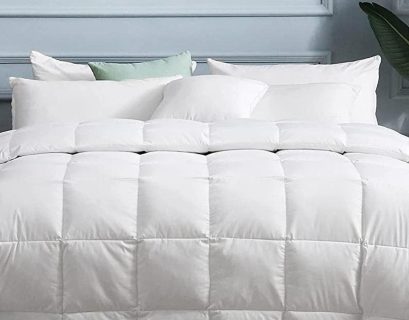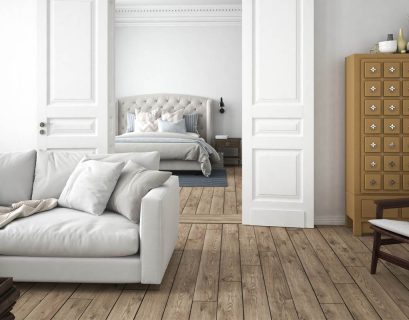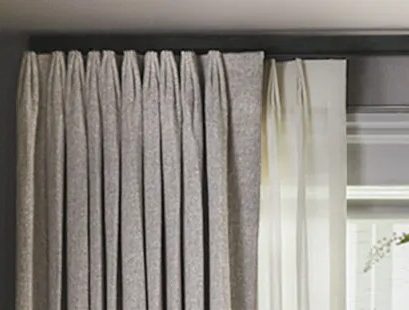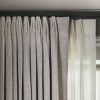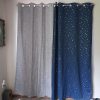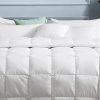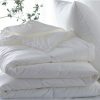The realm of bedding is vast and varied, offering a plethora of choices to cocoon ourselves in comfort during our nightly slumber. Two popular bedding options that often cause confusion are duvet covers and comforters. While they both contribute to a cozy and stylish bed, they serve distinct purposes and come with unique features. In this comprehensive guide, we will unravel the mystery behind duvet covers and comforters, exploring the differences between these bedding essentials and helping you make an informed choice that suits your preferences and sleep style.
Duvet Cover: The Guardian of Comfort
Definition: A duvet cover is a protective fabric shell designed to encase and shield a duvet insert. Duvets are typically plain white and serve as the inner, insulating layer of bedding, while duvet covers act as a decorative and protective outer layer.
Construction: Duvet covers are crafted with openings at one end or along the bottom edge, allowing for easy insertion and removal of the duvet insert. They may feature closures like buttons, zippers, or ties to secure the insert within the cover.
Materials: Duvet covers come in a wide array of materials, including cotton, linen, microfiber, silk, and blends. The choice of material affects the feel, breathability, and overall aesthetic of the bedding.
Benefits:
- Versatility: Duvet covers offer the flexibility to change the look of your bedding without replacing the entire duvet. They come in a multitude of colors, patterns, and textures, allowing for easy bedroom transformations.
- Easy Cleaning: Duvet covers are machine washable, simplifying the cleaning process. This is especially advantageous for maintaining a fresh and hygienic sleep environment.
- Protection: Acting as a protective barrier, duvet covers shield the duvet insert from stains, spills, and general wear and tear. This extends the lifespan of the duvet and minimizes the need for frequent washings.
- Customization: With duvet covers, you can easily switch between different duvet inserts to adjust warmth levels based on the season or your personal comfort preferences.
Comforter: The All-in-One Cozy Companion
Definition: A comforter is a thick, quilted blanket filled with insulating materials, such as down, feathers, synthetic fibers, or a combination. Unlike duvets, comforters are standalone bedding items with an integrated filling, eliminating the need for a separate insert.
Construction: Comforters are typically sewn with a quilted or stitched pattern to keep the filling evenly distributed. The outer fabric, known as the shell, is chosen for its durability and aesthetic appeal.
Materials: Comforters can be filled with various materials, each offering different levels of warmth and breathability. Common fillings include down, which is sourced from duck or goose feathers, and synthetic fibers like polyester.
Benefits:
- Convenience: Comforters are an all-in-one bedding solution, eliminating the need for a separate duvet and cover. They come ready-made with the filling encased in a decorative outer shell.
- Warmth: Comforters are known for their warmth and coziness, providing a plush layer that traps heat and keeps you snug during colder nights.
- Aesthetic Appeal: Comforters come in a variety of colors, patterns, and designs. Their decorative shells add style and visual interest to the bed, making them a focal point in bedroom decor.
- Low Maintenance: While comforters may be bulkier and more challenging to launder than duvet covers, they require less frequent washing as the filling is integral to the structure. Many comforters are machine washable for easy care.
Key Differences:
- Function:
- Duvet Cover: Primarily serves as a protective and decorative outer layer for a duvet insert.
- Comforter: Functions as an all-in-one blanket with an integrated filling, eliminating the need for a separate duvet.
- Construction:
- Duvet Cover: A fabric shell with openings for inserting and removing a duvet. May have closures like buttons, zippers, or ties.
- Comforter: A quilted blanket with an integrated filling, typically sewn in a decorative pattern to keep the filling evenly distributed.
- Filling:
- Duvet Cover: Does not have an integrated filling; relies on a separate duvet insert for warmth and insulation.
- Comforter: Contains an insulating filling, such as down or synthetic fibers, providing warmth and comfort on its own.
- Customization:
- Duvet Cover: Allows for easy customization by changing the duvet insert, providing flexibility in warmth levels and aesthetics.
- Comforter: Comes pre-filled, limiting customization options. However, a variety of designs and patterns contribute to aesthetic customization.
- Cleaning:
- Duvet Cover: Machine washable, making cleaning and maintenance straightforward. Requires regular washing to keep the sleeping environment hygienic.
- Comforter: Bulkier and may require larger-capacity washing machines or professional cleaning. Requires less frequent washing compared to duvet covers.
Choosing Between Duvet Covers and Comforters:
- If You Prefer Versatility:
- Opt for a duvet cover if you enjoy changing the look of your bedding frequently. Duvet covers offer a wide range of style options and can be easily swapped to suit your mood or decor changes.
- If You Value Convenience:
- Choose a comforter if you prefer an all-in-one bedding solution. Comforters come ready-made with an integrated filling, eliminating the need for a separate duvet insert.
- If Customization Is Important:
- Duvet covers are ideal if you like adjusting the warmth of your bedding. You can choose different duvet inserts with varying fill weights to cater to different seasons or personal preferences.
- If Maintenance Matters:
- Duvet covers are easier to clean and maintain, as they can be machine washed regularly. Comforters may require less frequent washing but can be more cumbersome to clean due to their integrated filling.
Conclusion:
In the grand tapestry of bedding options, duvet covers and comforters each weave their unique threads of comfort, style, and functionality. Understanding the differences between these two bedding essentials allows you to make an informed decision based on your preferences, lifestyle, and sleep habits. Whether you opt for the versatile and customizable duvet cover or the all-in-one warmth of a comforter, both choices contribute to the cozy sanctuary we all crave for a restful night’s sleep.




